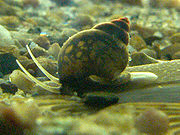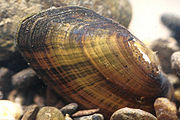
Freshwater mollusc
Encyclopedia




Phylum
In biology, a phylum The term was coined by Georges Cuvier from Greek φῦλον phylon, "race, stock," related to φυλή phyle, "tribe, clan." is a taxonomic rank below kingdom and above class. "Phylum" is equivalent to the botanical term division....
Mollusca
Mollusca
The Mollusca , common name molluscs or mollusksSpelled mollusks in the USA, see reasons given in Rosenberg's ; for the spelling mollusc see the reasons given by , is a large phylum of invertebrate animals. There are around 85,000 recognized extant species of molluscs. Mollusca is the largest...
which live in freshwater
Freshwater
Fresh water is naturally occurring water on the Earth's surface in ice sheets, ice caps, glaciers, bogs, ponds, lakes, rivers and streams, and underground as groundwater in aquifers and underground streams. Fresh water is generally characterized by having low concentrations of dissolved salts and...
habitat
Habitat
* Habitat , a place where a species lives and grows*Human habitat, a place where humans live, work or play** Space habitat, a space station intended as a permanent settlement...
s, both lotic (flowing water) such as rivers, streams, canals, springs, and underground cave streams (stygobite species) and lentic (still water) such as lakes, ponds (including temporary or vernal ponds), and ditches.
This article is about freshwater Mollusca in general; for information on one particular family of freshwater molluscs, please follow the appropriate links in the lists below.
The two major classes of molluscs have representatives in freshwater: the gastropods (snails) and the bivalves (freshwater mussel
Mussel
The common name mussel is used for members of several families of clams or bivalvia mollusca, from saltwater and freshwater habitats. These groups have in common a shell whose outline is elongated and asymmetrical compared with other edible clams, which are often more or less rounded or oval.The...
s and clam
Clam
The word "clam" can be applied to freshwater mussels, and other freshwater bivalves, as well as marine bivalves.In the United States, "clam" can be used in several different ways: one, as a general term covering all bivalve molluscs...
s.) It appears that the other classes within the Phylum Mollusca -the cephalopods, scaphopods, polyplacophorans, etc. - never made the transition from a fully marine environment to a freshwater environment.
A few species of freshwater molluscs are among the most notorious invasive species
Invasive species
"Invasive species", or invasive exotics, is a nomenclature term and categorization phrase used for flora and fauna, and for specific restoration-preservation processes in native habitats, with several definitions....
. In contrast, numerous others have become threatened or have become extinct in the face of anthropogenic change.
Biogeography
Typical freshwater species (such as many river mussel species in the family UnionidaeUnionidae
Unionidae is a family of freshwater mussels, the largest in the order Unionoida, the bivalve mollusks sometimes known as river mussels, naiads, or simply as unionids.The range of distribution for this family is world-wide...
) have a range
Range (biology)
In biology, the range or distribution of a species is the geographical area within which that species can be found. Within that range, dispersion is variation in local density.The term is often qualified:...
which may consist of a series of adjacent river systems, a series of adjacent tributaries, or part of a single large river system. Large rivers and small tributary creeks typically share few species, and distribution patterns suggest large lowland rivers represent substantial barriers to the dispersal of species adapted to small upland streams. Endemism is common in some families, and species may be endemic to a single creek or spring. In contrast, some of the tiny pill clams
Pisidium
Pisidium is a genus of very small or minute freshwater clams known as pill clams or pea clams, aquatic bivalve molluscs in the family Sphaeriidae.-Subgenera and species:Subgenera and species within the genus Pisidium include:...
have a nearly worldwide distribution (Burch, 1972)
Ecological and anatomical challenges
Challenges in the natural environment faced by freshwater Mollusca include floods, droughts, siltation, extreme temperature variations, predation, and the constant unidirectional flow characteristic of river habitats. OsmoregulationOsmoregulation
Osmoregulation is the active regulation of the osmotic pressure of an organism's fluids to maintain the homeostasis of the organism's water content; that is it keeps the organism's fluids from becoming too diluted or too concentrated. Osmotic pressure is a measure of the tendency of water to move...
, or the maintenance of constant salinity within body tissure and fluids, is another challenge faced by freshwater Mollusca. Dillon (2000) indicates that they have characteristically low tissue salinities relative to other freshwater animals, and unionoid mussels have some of the lowest tissue salinities of any animal.
Freshwater bivalves
Families of freshwater bivalves occur within the orders UnionoidaUnionoida
Unionoida is an order of freshwater mussels, aquatic bivalve mollusks. The order includes most of the larger freshwater mussels, including the freshwater pearl mussels...
and Veneroida
Veneroida
The Veneroida or veneroids are an order of bivalve molluscs. They include some familiar forms such as saltwater clams and cockles, and a number of freshwater bivalves including zebra mussels....
.
Freshwater gastropods
Ten families of prosobranchiate snails (gilled operculateOperculum (gastropod)
The operculum, meaning little lid, is a corneous or calcareous anatomical structure which exists in many groups of sea snails and freshwater snails, and also in a few groups of land snails...
snails) and five pulmonate families (lunged snails, distantly related to common landsnails) inhabit freshwater environments in many parts of the world. Some freshwater snail
Freshwater snail
A freshwater snail is one kind of freshwater mollusc, the other kind being freshwater clams and mussels, i.e. freshwater bivalves. Specifically a freshwater snail is a gastropod that lives in a watery non-marine habitat. The majority of freshwater gastropods have a shell, with very few exceptions....
species serve as hosts
Host (biology)
In biology, a host is an organism that harbors a parasite, or a mutual or commensal symbiont, typically providing nourishment and shelter. In botany, a host plant is one that supplies food resources and substrate for certain insects or other fauna...
for human and animal parasites.

